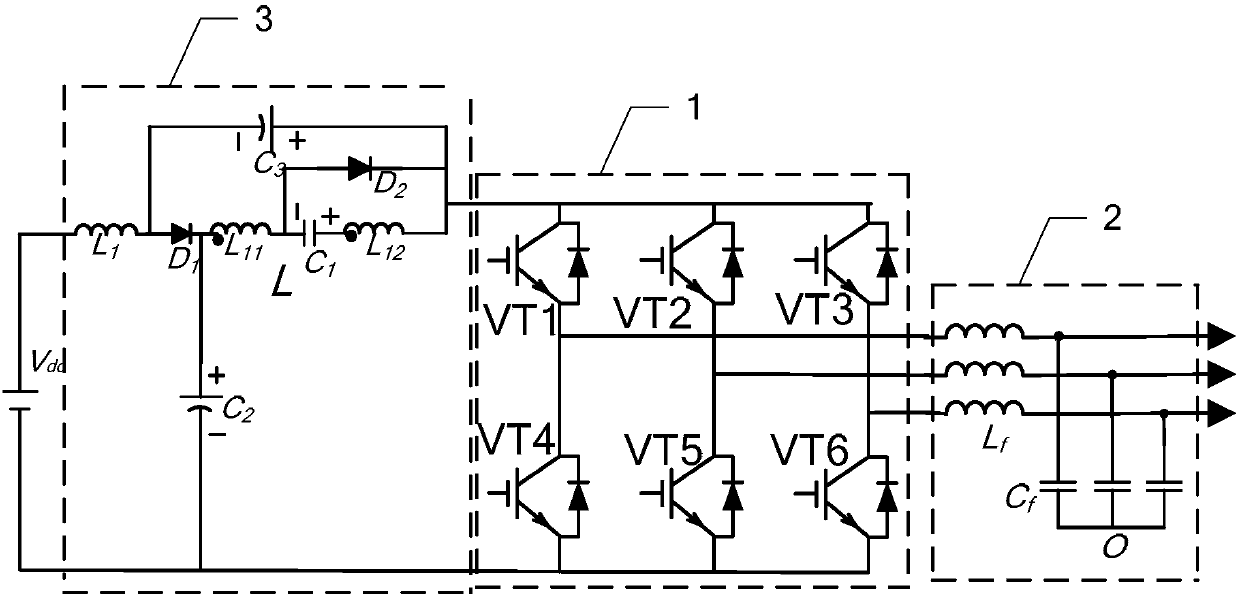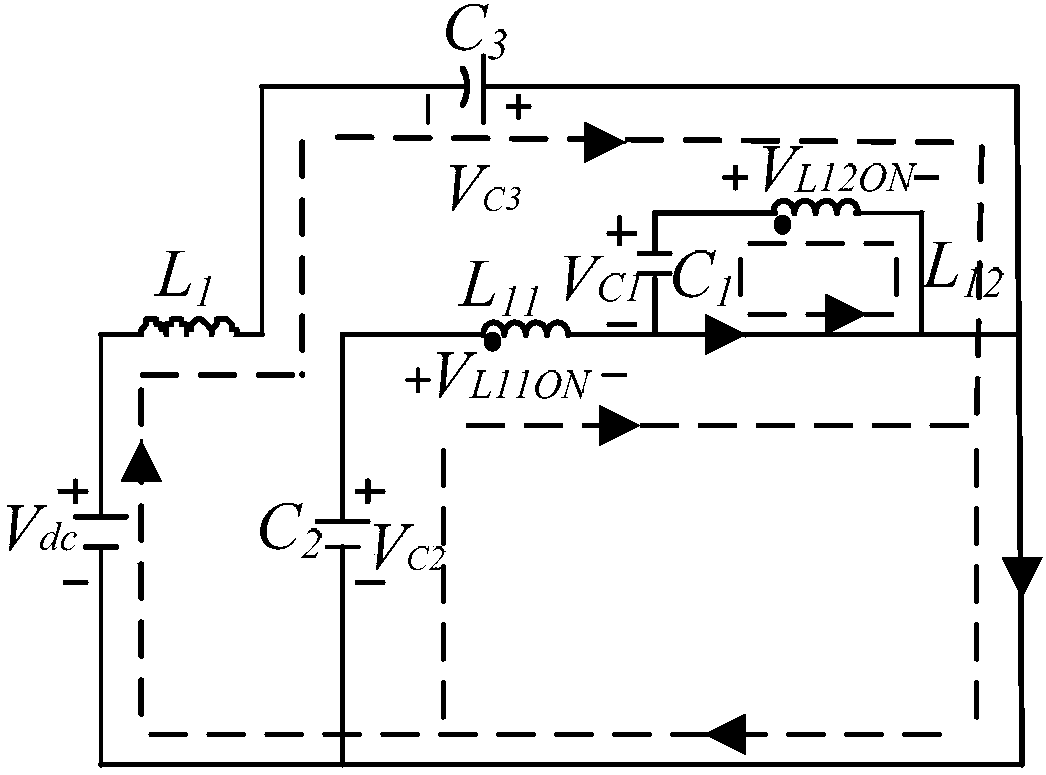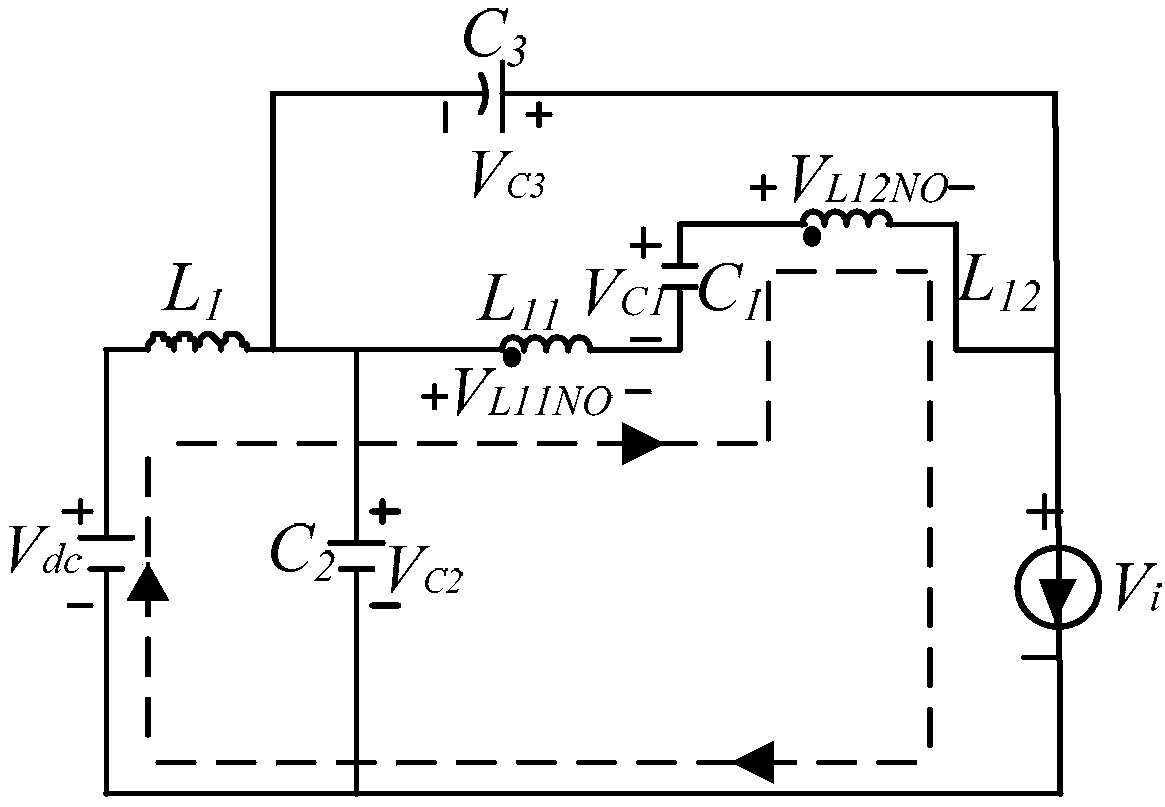Coupling inductance quasi-Z source inverter based on voltage doubling capacitor and modulation method of coupling inductance quasi-z source inverter
A technology of coupled inductance and voltage doubling capacitor, which is applied in the direction of converting irreversible DC power input into AC power output, electrical components, and output power conversion devices, etc., can solve the limitation of boosting capability and increase the harmonic content of output voltage. , large resonant current and other problems, to achieve the effect of suppressing resonant current, improving boost capability and reducing voltage stress
- Summary
- Abstract
- Description
- Claims
- Application Information
AI Technical Summary
Problems solved by technology
Method used
Image
Examples
specific Embodiment approach 1
[0035] Specific implementation mode one: refer to figure 1 Specifically illustrate the present embodiment, the coupled inductance quasi-Z source inverter based on the voltage doubler capacitor described in the present embodiment includes a three-phase inverter 1 and an output filter 2,
[0036] The AC signal output terminal of the three-phase inverter 1 is connected to the AC signal input terminal of the output filter 2, and the voltage output by the filtered signal output terminal of the output filter 2 supplies power to the load;
[0037] It is characterized in that it also includes a quasi-Z source network 3,
[0038] The quasi-Z source network 3 includes an electrolytic capacitor C 1 -C 3 , coupled inductance L, inductance L 1 and diode D 1 -D 2 ,
[0039] The positive pole of the DC power supply is connected to the inductance L 1 One end of the inductor L 1 The other end of the diode D is connected simultaneously 1 positive electrode and electrolytic capacitor C ...
specific Embodiment approach 2
[0043] Specific implementation mode two: refer to Figure 2 to Figure 3 This embodiment is described in detail. This embodiment is to further illustrate the coupled inductance quasi-Z source inverter based on the voltage doubler capacitor described in the first embodiment. In this embodiment, the three-phase inverter 1 has two kinds of work state, which are straight-through state and normal state;
[0044] When the upper and lower bridge arms of the three-phase inverter 1 are in the straight-through state, the quasi-Z source network 3 is disconnected from the three-phase inverter 1, and the electrolytic capacitor C 3 and DC power to the inductor L 1 charging, the electrolytic capacitor C 2 Charge the primary winding of the coupled inductor, the secondary winding L of the coupled inductor L 12 through diode D 2 to the electrolytic capacitor C 1 Charge to achieve double voltage;
[0045] When the three-phase inverter 1 is in a normal working state, the quasi-Z source netwo...
specific Embodiment approach 3
[0046] Specific embodiment three: This embodiment is to further explain the coupled inductance quasi-Z source inverter based on the voltage doubler capacitor described in the second specific embodiment. In this embodiment, the voltage doubling is realized, specifically:
[0047] Set in a switching cycle T, the duration of the straight-through state is T 0 , then in the straight-through state, the voltage in the quasi-Z source network 3 is:
[0048]
[0049] In the formula, V L1ON Inductance L in the through state 1 Voltage across the terminal, V L11ON is the voltage across the primary winding of the coupled inductor in the through state, V L12ON is the voltage across the secondary winding of the coupled inductor in the straight-through state, V dc is the DC voltage input by the quasi-Z source network, V i is the input terminal voltage of the three-phase inverter, V C1 is the electrolytic capacitor C in the through state 1 voltage, V C2 is the electrolytic capacitor ...
PUM
 Login to View More
Login to View More Abstract
Description
Claims
Application Information
 Login to View More
Login to View More - R&D
- Intellectual Property
- Life Sciences
- Materials
- Tech Scout
- Unparalleled Data Quality
- Higher Quality Content
- 60% Fewer Hallucinations
Browse by: Latest US Patents, China's latest patents, Technical Efficacy Thesaurus, Application Domain, Technology Topic, Popular Technical Reports.
© 2025 PatSnap. All rights reserved.Legal|Privacy policy|Modern Slavery Act Transparency Statement|Sitemap|About US| Contact US: help@patsnap.com



